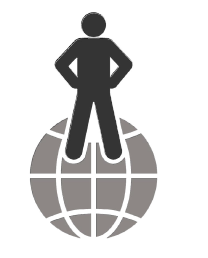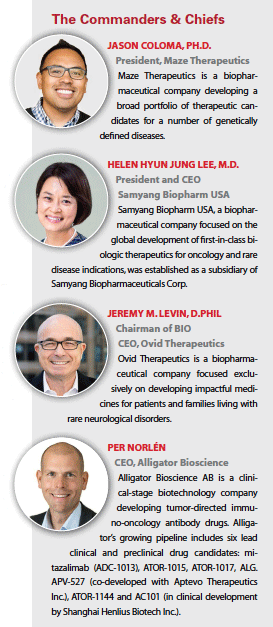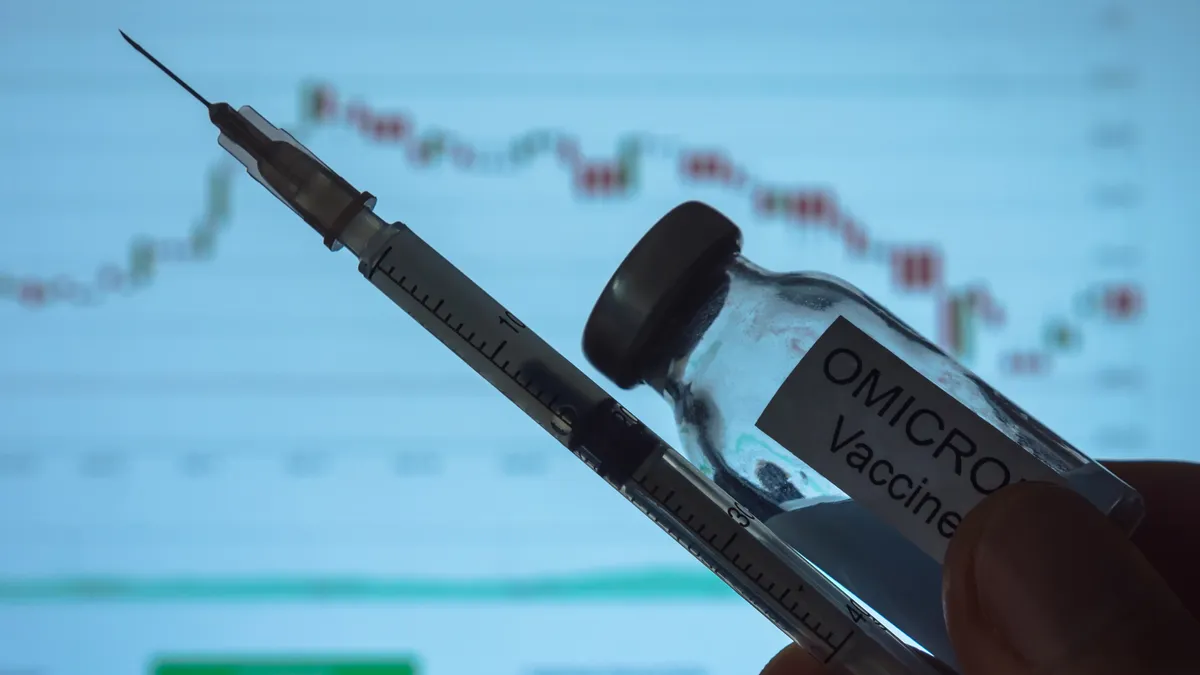Biotech and biopharma executives provide their insights on what the future holds for their sector of the industry.
 What should we expect to see from the biotech/biopharma industry in the coming decade?
What should we expect to see from the biotech/biopharma industry in the coming decade?
Coloma. We will see transformative-level improvement in the way we discover, develop, and commercialize drugs as a response to the changing reimbursement landscape
Hyun Jung Lee. We will see an increased focus on rare diseases, rare cancers, and novel and disruptive development platforms, such as CRISPR and gene/cell therapy. We will also see innovative delivery systems for gene therapy, novel, and improved manufacturing processes to accommodate the new development platforms, a continued focus on partnering to supplement drug pipelines, and proactive pricing strategies that allow for wider and greater patient access.
Levin. Our industry faces a significant challenge in the United States. Policies enacted that affect intellectual property and trade policy, coupled with the evolution of the payers, pricing, and hospital industry longer term will occasion much thought about business models and investment decisions in innovation. At the same time, absent political and social upheaval, we can expect innovation and biotech to surge in China.
Norlén. Personalized and precision medicines represent the next evolution in healthcare and how patients are treated. Building on the initial cell therapies that have been approved by regulators, I believe the next decade will take us further beyond the traditional one-size-fits-all approach, in which many patients are treated with the same therapy. In the field of oncology, the development of personal cancer vaccines will accelerate. This is an approach that has long been explored due to its enormous potential but has largely failed to demonstrate success until now because of our evolving knowledge base around tumor biology and technological advancements in genomics.
What technology are you most closely tracking and what impact do you believe it will have on the industry in the coming years?
 Coloma. There are several technologies that I am watching, including the array of tools being used in functional genomics such as CRISPR and single cell genomics, that are exponentially improving our understanding of the biology and pathophysiology of certain diseases.
Coloma. There are several technologies that I am watching, including the array of tools being used in functional genomics such as CRISPR and single cell genomics, that are exponentially improving our understanding of the biology and pathophysiology of certain diseases.
Hyun Jung Lee. Certainly gene therapy has shown early promise, which speaks to potentially greater long-term potential. Delivering copies of genes provides a possible method that may have the potential of moving beyond just attacking a disease symptomatically or managing the illness as a chronic disease and provide the process by which illnesses may be corrected or cured at a very basic level. We are excited by the opportunities that immuno-oncology presents and have recently entered into a collaboration to develop an immuno-oncology agent. Historically, cancer treatment has followed distinct paths with varying levels of success: surgery, radiation, chemotherapy, and targeted therapy. We join the growing field of industry researchers who feel that future standards of cancer care will be found in the growing number of immuno-oncology drugs currently under development.
Levin. Cell and genetic therapies will shape not just treatment paradigms, but also the way patients are treated and where they are treated. In turn, this will mean the most successful segments of the industry will become more interwoven with patients, and at the same time companies will need to tackle the critical manufacturing and intellectual property challenges that these technologies bring.
Norlén. Technological advancements in gene sequencing over recent years have been staggering. The first human genome to be sequenced took more than a decade. Gene sequencing can now be done in 24 hours. In addition, the genetic information that cost billions to extract in 1990 can now be obtained for a couple of hundred pounds or dollars.
That ability will help to improve understanding of diseases, identify multiple subtypes of what would previously have been thought of as a single disease, and allow patients to be stratified for treatment with the most effective therapy. Ultimately, this technology will help us to truly unleash the potential of personalized therapies.
As a biotech/biopharma CEO what is the biggest issue that keeps you up at night?
Coloma. Talent recruitment and retention is the biggest issue for me. People are the most important asset for a company.
Hyun Jung Lee. I think of our patients daily. I am always thinking of their well-being and hope for their health improvements. My hope is always that tomorrow is a “breakthrough" day for our patients as they interact with their doctors.
As a CEO, I am also constantly mindful of finding, hiring, maintaining, and developing a talented team of people that reflect our values and can be matched with the needs of our company. This is an incredibly challenging aspect of my position. Samyang is poised for rapid growth and my hope is that we are able to continue to meet the demands of this growth, along with evolving roles and responsibilities. It’s difficult to establish a well-functioning team that meets “today’s needs" and that grows into the needs required for “tomorrow’s business." Even as a company in its infancy, we have been successful in doing this so far with seven employees, and I want to be able to continue to scale the success we’ve had to date as we grow.
Levin. An area of concern for me is the manner in which we have allowed the perception of our industry to deteriorate and the implications of such a shift for patients, innovation, shareholders and, eventually, U.S. leadership in this critical arena.
Norlén. Notwithstanding the huge amount of progress that has been made over the past decade improving outcomes for cancer patients through targeted medicines and precision therapies, I still spend a lot of time thinking about when we will see that leap in innovation to not just control cancer but to cure it.
A more practical issue for someone in my position, leading a company discovering and developing potential new cancer therapies, is the increased competition in our field — there are so many compounds in development, so many clinical trials underway exploring monotherapies, combinations and combinations of combinations. This is making it more difficult to get the attention of potential future pharma partners. Showing the potential of your compound is tough and today requires solid efficacy data with those in biotech having to invest more money and a longer time in each project.
What should we expect in terms of funding, what are investors looking for?
Coloma. As a former VC, I know that investors have a certain pattern recognition. Strong team with real leadership, strong science, and a thoughtful plan to value creation.
Hyun Jung Lee. Investors are looking for proven leadership and a track record of success of the executive team, novel scientific thinking, high integrity and ethics, strong innovative corporate culture, methods to augment the current development process that is quicker and less expensive, and a clear and proactive partnering strategy.
Levin. The same as always: robust returns on investment generated by successful new products and innovative technologies.
Norlén. Investors want what they have always wanted — great molecules with fantastic potential and the highest chances of success — as we all do. And increasingly, they want to see later stage data to provide more confidence in their investments. I’m confident that there is funding available to support innovation in the biotech sector. I’m also confident that we will see continued collaboration between companies, and more and more M&A deals with big pharma companies that are looking for the great science to complement their pipelines and portfolios. This will increase within the oncology field as combination therapies become the standard approach to treat cancer.
What is the biggest opportunity you envision for the biotech/biopharma industry in the coming decade?
Coloma. We will look back at the next decade as the one where human healthcare was fundamentally transformed and many diseases were cured outright.
Hyun Jung Lee. I think our industry will remain competitive by ensuring affordability, quality, and delivery performance. Samyang along with the rest of the industry will succeed if we are able to develop, maintain, and grow both technically and operationally.
Companies that are able to discover and master new drug development platforms will likely have the greatest chance for success. I also think the concept of developing targeted medicines that serve a smaller patient population, but with greater effectiveness is a direction in which the industry will continue to follow. The challenge is to develop and implement technologies that allow for swifter and more targeted pipeline development that leads to commercial success. Our industry was created on scientific innovation, but now we must create opportunities for that creativity to flourish within a business environment that is strong operationally and focused on combining that science with intelligent business practices.
Levin. The focus is on regaining the trust and respect of the people of the United States by our actions and statements.
Norlén. For the field of immuno-oncology the growing competition is both a curse and a blessing. With the number of products under evaluation our understanding of how to use the immune system to treat cancer is growing at an unprecedented speed, and this will be the single most important factor to allow ground-breaking innovation.(PV)



















